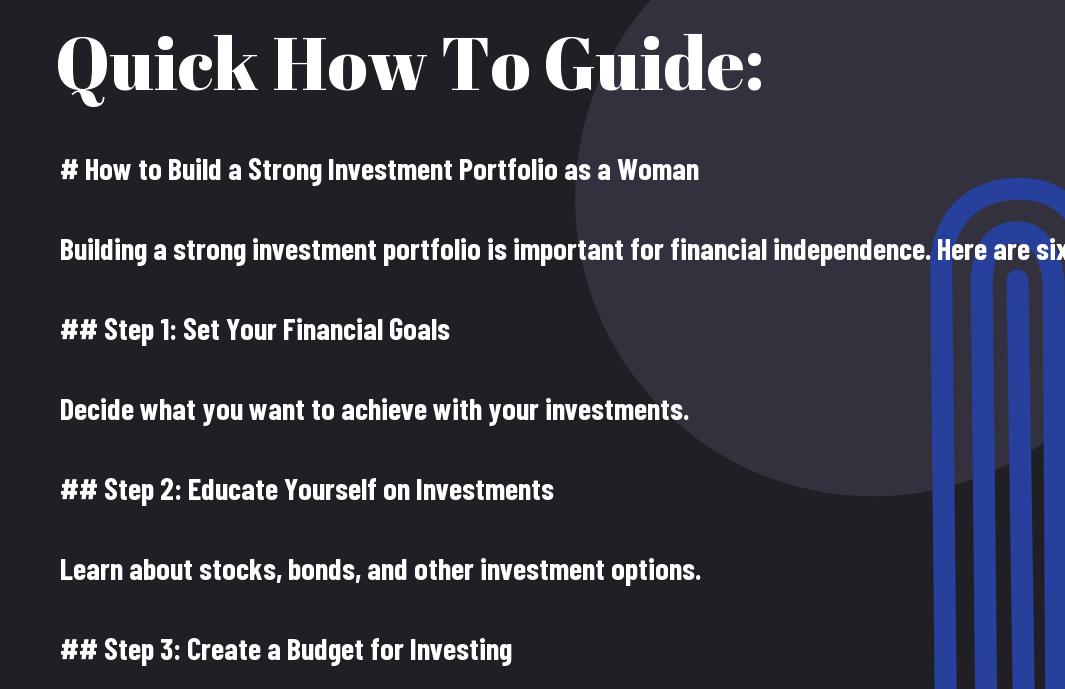There’s never been a better time for you to take control of your financial future. Building a strong investment portfolio is vital for achieving your long-term goals. As a woman, you may face unique challenges in the investment world. However, with the right strategies and knowledge, you can overcome these obstacles and create a portfolio that works for you. This guide will walk you through the steps to confidently make smart investment choices tailored to your needs.

Key Takeaways:
- Educate yourself about different investment options. Understand stocks, bonds, and mutual funds so you can make informed choices.
- Diversify your portfolio by investing in various sectors. This can help reduce risk and increase potential returns over time.
- Stay consistent with your investment strategy. Regular contributions, even small amounts, can lead to significant growth in your portfolio.

Understanding Investment Portfolios
The foundation of building wealth is understanding investment portfolios. They are collections of various investments that work together to help you reach your financial goals. You can learn about The Best Personal Investment Strategy – For Women (and Men) to discover strategies tailored for your needs.
What is an Investment Portfolio?
There’s a common saying in finance: “Don’t put all your eggs in one basket.” An investment portfolio is much like this saying. It includes a mix of different investment types, such as stocks, bonds, and real estate. This mix aims to grow your wealth over time.
Importance of a Diversified Portfolio
One of the best ways to protect your investments is by diversifying your portfolio. A diversified portfolio spreads your money across various assets. This way, if one investment goes down, others might still perform well. This balance can safeguard your overall financial health.
Investment diversification is important because it reduces risk. For example, if you only invest in one company and it fails, you could lose a large sum of money. However, if your money is spread across several investments, a downturn in one may not impact you as severely. By mixing different asset classes, you can create a more stable financial future and potentially earn better returns.

Key Factors to Consider
While building a strong investment portfolio as a woman, there are several key factors to keep in mind. These factors can guide your decisions and help you achieve your financial goals. Consider the following:
- Your risk tolerance
- Your investment goals
- Your time horizon
- Market trends
- Expert advice
Any investment journey you take is better informed when you consider these aspects. For more insights, check out Women and Investing: How to Grow Your Wealth & Own ….
Risk Tolerance
Any investor needs to understand their risk tolerance. This means knowing how much risk you are comfortable taking with your investments. Some people prefer safer options, while others can handle more volatility. Evaluating your financial situation, investment experience, and emotional comfort can all help you determine your risk tolerance.
Investment Goals
Clearly, defining your investment goals is vital to your success. Ask yourself what you want to achieve. Are you saving for retirement, a house, or your child’s education? Each goal has a different time frame and will influence your investment choices. By outlining these goals, you can create a roadmap for your financial journey.
Tolerance for risk is also closely tied to your investment goals. For short-term goals, you may want safer investments to protect your capital. For long-term objectives, you can afford more risk since you have time to recover from potential losses. This balance helps to align your investments with your personal ambitions.
How to Start Investing
To start investing, you need to take a step-by-step approach. First, educate yourself about different types of investments, such as stocks, bonds, and mutual funds. Next, determine how much money you can invest regularly. It’s necessary to set clear financial goals and have a plan in place. Lastly, consider speaking with a financial advisor for personalized advice tailored to your situation. By taking these initial actions, you’ll be on your way to building a strong investment portfolio that fits your needs.
Building a Budget
While starting to invest, it’s important to build a budget first. Take a close look at your income and expenses. Calculate your monthly savings potential by tracking where your money goes. This will help you see how much you can set aside for investments. Aim to save at least 20% of your income for investments and emergencies. Keeping a budget not only helps with investments but also promotes financial stability in the long run.
Choosing Your Investment Medium
Budget for your investment medium carefully. Understanding where to put your money is vital for growing your wealth over time. You can choose between traditional mediums like stocks and bonds or modern options like real estate and cryptocurrencies. Each option has different risk levels and potential returns. It’s important to find a balance that matches your comfort level and investment goals.
Another way to choose your investment medium is to consider the risks and returns associated with each type. For example, stocks can offer high returns but can also be volatile. Bonds tend to be safer but often yield lower returns. Real estate can provide steady rental income, while cryptocurrencies can be incredibly risky. Research each option and think about how each fits into your overall financial plan. This will ensure you make informed decisions that align with your investment strategy.
Tips for Women Investors
Once again, building a strong investment portfolio is necessary for financial independence. Here are some tips to help you navigate the investment landscape:
- Start investing early.
- Diversify your portfolio.
- Consider low-cost index funds.
- Stay informed about market trends.
- Be patient; investing is a long-term game.
Assume that following these tips can lead to better investment choices and financial growth.
Seek Financial Education
Some women feel hesitant to invest because of a lack of knowledge. Educate yourself about different investment options, risks, and returns. Many online resources, courses, and books are available that can help you understand the basics of investing. Choose materials that explain concepts in simple terms. Your confidence will grow as you learn more about the investment world.
Join Investment Communities
You can greatly benefit from being part of investment communities. These groups provide support, guidance, and shared knowledge. Connecting with others who have similar financial goals can help you feel more confident in your decisions.
Tips from like-minded individuals can be invaluable. You can share experiences, ask questions, and learn about successful strategies. Participating in discussions helps broaden your understanding of various investment approaches. Plus, you’ll find encouragement from others on the same journey. Seek out local groups or online forums to connect with other women investors and expand your network.
Strategies for Building Wealth
Not every investment strategy is the same. Building wealth involves understanding your goals and choosing the right mix of investments. You may want to consider a blend of stocks, bonds, and real estate. Each option has pros and cons. By diversifying, you reduce risk and increase your chances of financial growth. Take your time to explore different strategies to find what works best for you.
Long-term vs. Short-term Investments
On your investment journey, you will face a choice between long-term and short-term investments. Long-term investments, such as stocks or mutual funds, typically require patience but can yield higher returns over time. Short-term investments, like savings accounts or bonds, can provide quick cash. Assess your financial goals to determine which approach suits you best.
Rebalancing Your Portfolio
To keep your investment portfolio aligned with your goals, regular rebalancing is crucial. This means adjusting your asset mix to maintain your desired level of risk. For example, if stocks perform well and make up a larger part of your portfolio than intended, you might sell some shares and buy bonds to balance it out.
Plus, rebalancing helps you buy low and sell high, which can improve your returns. By reviewing your portfolio every six months to a year, you can stay on track with your investment strategy. Make changes as needed to ensure your investments reflect your current financial situation and goals.

Common Mistakes to Avoid
After building your investment portfolio, it’s important to steer clear of common pitfalls that can hinder your success. Many women, and investors in general, fall into traps that can jeopardize their financial goals. By being aware of these mistakes, you can make better decisions and grow your investments more effectively.
Emotional Investing
Investing can often feel overwhelming. It’s easy to let your feelings guide your decisions during market highs and lows. Instead of reacting emotionally, focus on your long-term goals and stick to your investment plan. This approach helps you avoid making hasty decisions that could hurt your portfolio.
Ignoring Research
Some investors skip important research, which can lead to poor investment choices. Taking the time to study the market, companies, and trends can significantly improve your results. Knowledge is power when it comes to investing, so prioritize learning to make informed decisions that align with your goals.
Avoid overlooking key data and expert insights when considering your investments. Review financial reports, market trends, and expert opinions regularly. This information helps you spot opportunities and make sound choices. Staying informed reduces risks and allows you to adapt your strategy based on current market conditions.
Final Words
From above, you can see that building a strong investment portfolio as a woman is possible with the right approach. Start by setting clear financial goals and understanding your risk tolerance. Diversify your investments to spread risk and stay informed about market trends. For guidance, consider seeking advice from financial advisors or investing in educational resources. With consistent effort and smart strategies, you can create a robust portfolio that aligns with your financial objectives. Take these steps now, and watch your investments grow over time.
FAQ: How to Build a Strong Investment Portfolio as a Woman
Q: Why is it important for women to invest?
A: Investing helps women grow their wealth over time. It can provide financial independence and security. Women often live longer than men, so it’s crucial to have enough savings for retirement. Investing also empowers women to achieve their financial goals, whether it’s buying a home, starting a business, or planning for education expenses.
Q: What are the first steps to creating an investment portfolio?
A: Start by setting clear financial goals. Ask yourself: What do you want to achieve with your investments? After that, create a budget. Determine how much money you can invest regularly. Next, educate yourself on different investment options, such as stocks, bonds, and mutual funds. Finally, choose a secure brokerage platform that matches your needs.
Q: How can women overcome barriers to investing?
A: Many women face challenges like lack of confidence or access to financial education. To overcome this, seek information from reliable sources or attend workshops focused on women and investing. Join online communities or local groups that discuss investment topics. Surrounding yourself with supportive women can boost your confidence and help you learn more about investing.
Q: What are the best types of investments for beginners?
A: Beginners may want to start with mutual funds or exchange-traded funds (ETFs). These options allow you to invest in a variety of assets at once. Consider index funds, as they track specific market indexes and tend to have lower fees. Dollar-cost averaging is another strategy where you invest a fixed amount regularly, reducing the impact of market fluctuations.
Q: How can I assess the performance of my investment portfolio?
A: Keep track of your investments regularly. Review your portfolio at least once a year. Check how your investments are performing against your goals. Use tools or apps that provide performance reports. Don’t hesitate to adjust your strategy if your investments are not meeting your expectations. Consulting with a financial advisor can also help guide your decisions.
Key Takeaways
- Investing provides financial security and independence for women.
- Set clear financial goals and create a budget for investing.
- Overcome barriers by seeking education, support, and community.
- Start with mutual funds or ETFs for a diversified investment approach.
- Regularly assess your portfolio and adjust strategies as needed.
To sum up, investing is a powerful tool for women to build wealth. By taking small, informed steps, you can create a strong investment portfolio that aligns with your financial goals.




